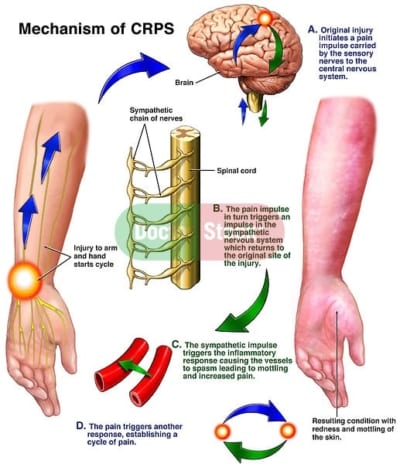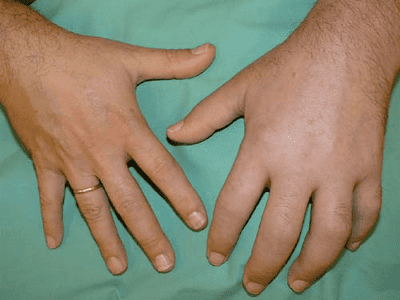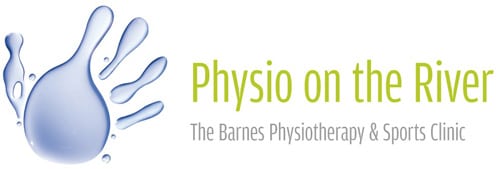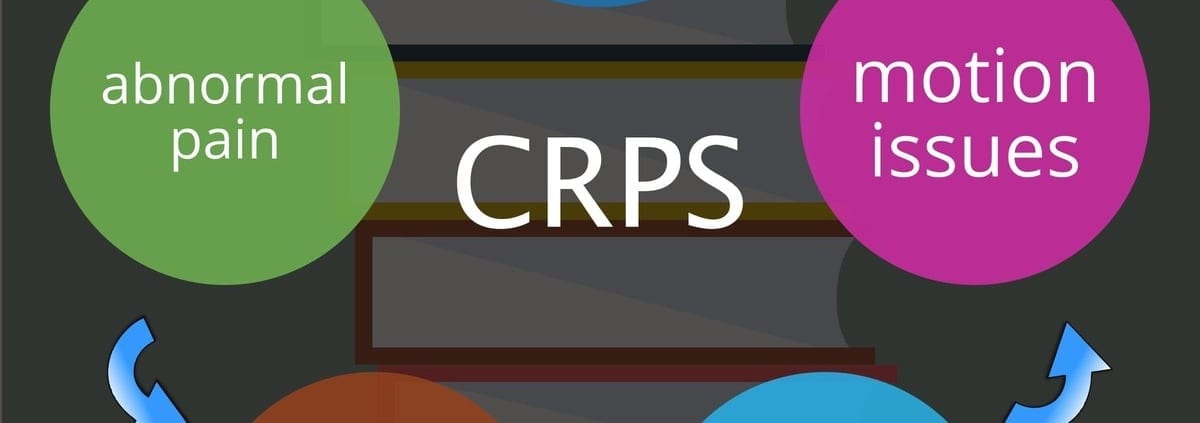Complex Regional Pain Syndrome – what’s it all about and how can we help?
The month of November is Complex Regional Pain Syndrome (CRPS) awareness month so we though we would try and shed some light on this complicated and painful syndrome.
Richard Game is one of our team of Physiotherapists and he undertook a Master’s degree in Pain Science in 2006. I did a Q & A session with him to find out more about this uncommon condition.
Q1. Hi Richard. Could you please explain to our readers what CRPS is?
 Richard: yes of course – CRPS is the term given to a group of conditions that involve severe pain that is beyond what the initial injury normally involves. It is usually associated with two or more of the following symptoms: swelling, colour changes, temperature changes, hair growth or loss, nail changes, numbness, weakness and wasting.
Richard: yes of course – CRPS is the term given to a group of conditions that involve severe pain that is beyond what the initial injury normally involves. It is usually associated with two or more of the following symptoms: swelling, colour changes, temperature changes, hair growth or loss, nail changes, numbness, weakness and wasting.
CRPS is a condition that varies greatly from person to person. So the management strategies that may work best for one person may not be totally suitable to another person.
Q2. I know there are two types of CRPS – could you explain the differences?
Richard:
CRPS I – involves the onset of some or all the previously mentioned symptoms, perhaps following an injury to a body part, although an injury is not always a feature. Indeed, some people suffer with it no obvious reason. In type I, there is no identifiable injury to any part of the nervous system directly.
CRPS II – can be described as type I, but the main difference is that there has been definite identifiable damage or injury to a major nerve or part of the nervous system and neuropathic pain may be experienced.
Q3. How much is known about the disease?
Richard:  one of the features of CRPS that makes coping with the pain and symptoms more difficult is that there are many unanswered questions that patients may have. However, there are certain things we do know and they are:
one of the features of CRPS that makes coping with the pain and symptoms more difficult is that there are many unanswered questions that patients may have. However, there are certain things we do know and they are:
- Inactivity, either forced or in order to avoid bringing on the pain, severely worsens the syndrome
- Secondary problems such as osteoporosis, muscle loss and contractures are due to inactivity and are also a part of the disease process
- CRPS affects more women than men
- Though uncommon, children can be affected by this condition
- The pain is most commonly in hands & wrists or feet and ankles but can often spreads further up the limb
- All authorities on the syndrome agree on the importance of early detection and most vitally, mobilisation and strengthening through home exercises and physiotherapy led exercise programs. This should also include some psychosocial input to provide coping mechanisms to deal with the day to day experiences of living with the syndrome and to help with any inactivity
- Medications can include drugs targeting all the aspects of pain & symptoms. However, no single medication will work for everyone, so you may have to be trialled on several different medications before you can get the right mixture for you
Q4. Can you give an example of the sort of patients you have seen with the condition?
Richard: yes, of course. Probably the most common scenario I’ve seen is a middle aged woman following a wrist fracture. I’ve had a few patients over the years who have suffered with much more severe pain than would normally be expected and this has usually been in conjunction with marked swelling, sweating and colour changes in the skin. Another example was a young teenager who fractured their ankle and suffered with similar symptoms. Both were reluctant to move their injured wrist and ankle due to the pain when they did so.
I had to coax them into using the limb normally, exercising to free them from stiffness and strengthen their muscles and I used massage techniques to desensitise the hand and foot.
Q5. So is there any physical treatment that helps?
Richard: yes, physiotherapy is imperative in getting the most from any medical procedures undergone, preventing secondary movement & strength losses, maximising your function and controlling your pain.
The physiotherapy input is to manage a programme of exercises and sensory stimulation that is designed specifically for each individual CRPS sufferer. There is sound scientific evidence to show the importance of movement and exercise in the management of CRPS types I & II.
Q6. So how does exercise help?
Richard:
- Exercise causes the release of opioids – the body’s natural ‘happy drug’ that has an analgesic effect on pain
- Weight bearing exercise increases blood flow throughout the body, increases nutrition of the joints and helps in the prevention of osteoporosis
- A stretching program helps avoid contractures of the muscles and allows for better functional performance
- Cardiovascular exercise causes chemical reactions that can help control the level of pain
- Moving against an applied resistance will maintain & improve muscular strength, prevent muscle wasting and increase performance
- Taking part in a specific exercise regime helps monitor how your symptoms are changing over time
Q7. What exercises do you recommend?
Richard: it’s important to remember that your exercise programme is exactly that, YOUR EXERCISE PROGRAMME! The Physio will tailor the exercises to your particular physical needs.
Q8. I know people often find it difficult to stick to an exercise routine – have you any tips?
Richard: often it is hard to build a routine around the exercises and this is because there may be some perceived barriers to doing the exercises. Frequently mentioned barriers are not having the time, not believing you will be able to do it, or most commonly because it will hurt.
The important message here is that doing specific exercises through a certain amount of pain is beneficial in the overall management of your condition. Pain in this situation is not harmful and is not making your condition any worse – in fact it’s helping!
Q9. You mentioned sensory stimulation – what is that?
Richard: through research, it is known that due to changes within the nervous system (due to CRPS), individuals often have altered sensation.
 CRPS sufferers express feeling a huge variety of sensations such as burning pain, numbness, intense coldness, pins & needles, feeling of water running over the surface of their skin, deep ache, sharp pain and hyper-sensitivity. Sensory stimulation aims at reducing the level of these abnormal sensations by “bombarding” the nerves with different normal sensations. The techniques we use might include stroking the skin, tapping it, firm massage, hot & cold soaking, gentle poking with a blunt object and more.
CRPS sufferers express feeling a huge variety of sensations such as burning pain, numbness, intense coldness, pins & needles, feeling of water running over the surface of their skin, deep ache, sharp pain and hyper-sensitivity. Sensory stimulation aims at reducing the level of these abnormal sensations by “bombarding” the nerves with different normal sensations. The techniques we use might include stroking the skin, tapping it, firm massage, hot & cold soaking, gentle poking with a blunt object and more.
The over-riding message is that we can help you manage your rehabilitation on a daily basis, using simple strategies to help you live a more normal life. Although this condition is painful and hard to understand, we are here to support you.
Next steps…..
If you have been diagnosed with CRPS and would like to talk to Richard about your condition and how he might be able to help just
- call 020 8876 5690
- email us here
- or pop into the clinic for a chat – Richard is here on Mondays, Wednesdays and Fridays and some Saturdays so it’s best to call first.



